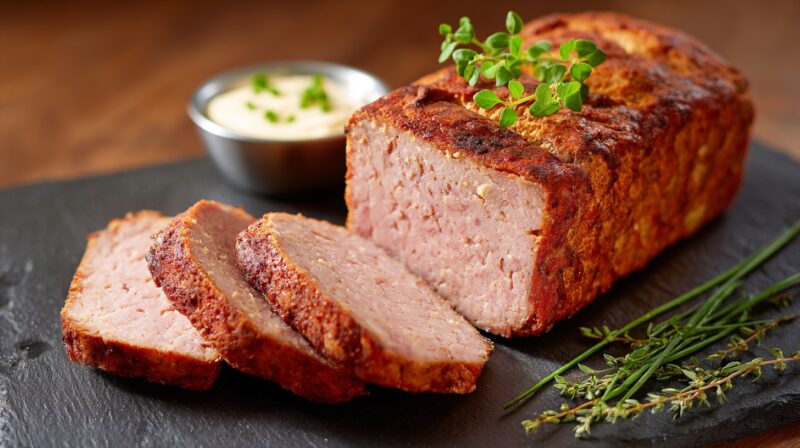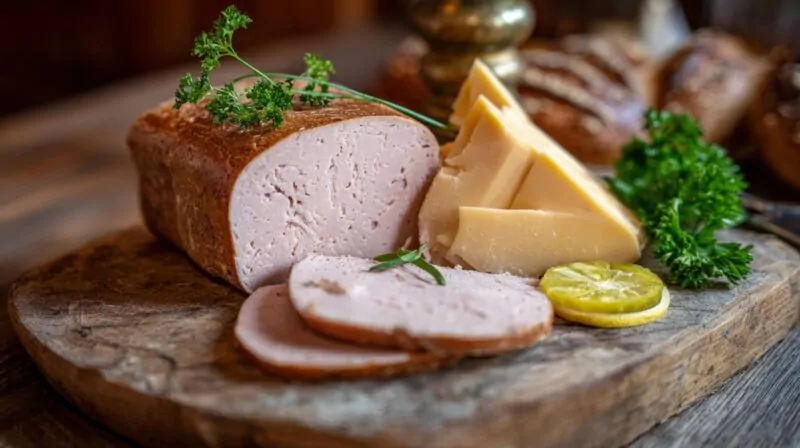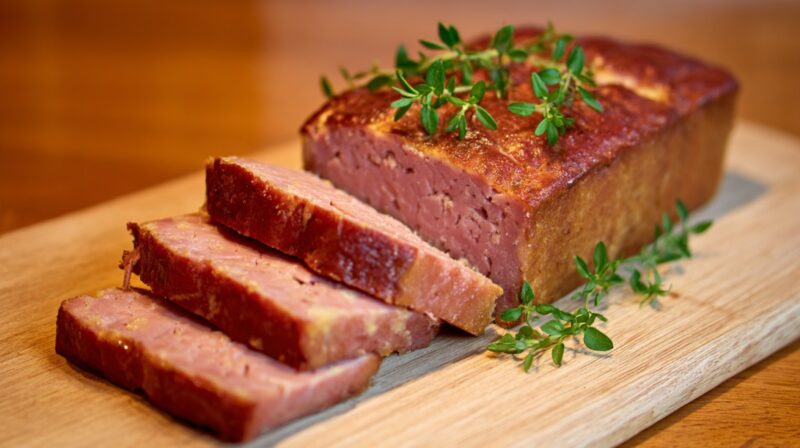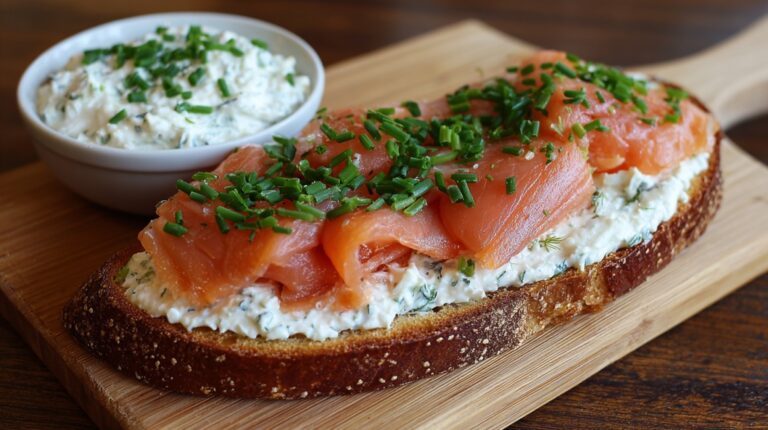
Leberkäse has long been celebrated as one of Germany’s most beloved specialties, often compared to meatloaf but carrying a personality of its own.
At first glance, its name causes plenty of confusion, since the literal translation reads “liver cheese.” Such a title leads outsiders to expect ingredients that usually never appear in the Bavarian version.
That linguistic twist sets the stage for an intriguing dish, both misunderstood and adored, that deserves a closer look.
Name vs. Reality: Misleading Translation
Leberkäse translates to “liver cheese,” which immediately sets up false expectations. In Bavaria, the loaf contains neither liver nor cheese, so newcomers often find the name baffling. Clues to the mystery lie in language history.
Some researchers argue that “Leber” connects not to organ meat but to “Laib,” the word for loaf. In the same vein, “Käse” in this older sense refers not to dairy but to a solid, dense mass.
Regional dialects across southern Germany strengthen this interpretation, showing how local speech shaped the label into its current form.

- Leber may derive from “Laib,” meaning loaf.
- Käse once signified a compact block, not cheese in the modern sense.
- Dialects in southern Germany carried these meanings into food naming traditions.
Legal distinctions add yet another layer of complexity. Outside Bavaria, rules require a certain percentage of liver in Leberkäse unless it carries the label “Bayerischer Leberkäse.” Inside Bavaria, producers follow the traditional recipe that omits liver entirely, reinforcing the dish’s role as comfort food.
Language, history, and regulation together explain why the name continues to confuse anyone tasting it for the first time.
Why the Misunderstanding Persists
Confusion remains tied to its name. Visitors expect liver and cheese, only to discover something different. That initial surprise lingers, making the misinterpretation easy to repeat. Regional laws amplify the issue.
Inside Bavaria, the standard loaf skips liver entirely, while outside Bavaria regulations demand some percentage of liver unless “Bayerischer Leberkäse” is specified. Such rules mean two diners in two cities can experience different versions under the same name.

- Name translation suggests incorrect ingredients.
- Legal rules differ by region, altering recipes.
- Culinary variations expand flavor and appearance, complicating expectations.
For locals, these differences enrich tradition, adding depth to their cultural food identity. For outsiders, the many faces of Leberkäse create inconsistency, making the dish simultaneously fascinating and confusing.
Historical & Cultural Origins
Origins of Leberkäse reach back more than two centuries, linking southern Germany, Austria, and Switzerland. Bavaria, however, has maintained the closest connection, treating it as part of regional identity.
Folklore ties its creation to a Munich butcher who served Elector Karl Theodor in 1776. While historians question the accuracy of this tale, the legend has endured as part of the dish’s story and adds a colorful layer to its reputation.
Over time, Leberkäse grew into a staple of everyday life. Workers embraced it as an affordable meal, while festival-goers saw it as a hearty snack to pair with beer.
Crossing into Austria and Switzerland further broadened its presence, yet Bavaria remains the cultural center for Leberkäse traditions, keeping its spirit alive in both casual and festive contexts.
Regional Variants and Culinary Creativity
@motioncookingofficial LEBERKÄS SELBER MACHEN 🇦🇹🍔 Ja, es is‘ tatsächlich so einfach 🥰 Was kommt bei euch ins Leberkas-Semmerl?! Senf, Kren, Gurkerl, Ketchup? Oder plain?! 🙌🏼🤔😄 #motioncooking #leberkäs #leberkässemmel #leberkässelbstgemacht ♬ Originalton – MotionCooking
Leberkäse may have begun as a straightforward loaf, but over time it has evolved into a canvas for regional flair and culinary imagination.
While the classic Bavarian version remains a favorite, many offshoots have developed, each adding a new layer of identity to the dish.
- Käseleberkäse: cubes of cheese melt into the loaf as it bakes, creating pockets of creamy texture that pair beautifully with the dense meat base.
- Pizzaleberkäse: peppers, pickles, and chunks of salami mimic the flavors of a pizza, making it a fun twist that appeals to younger generations and those looking for novelty.
- Pferdeleberkäse: horsemeat as the main ingredient reflects older traditions, especially in areas where horsemeat once played a larger role in local cuisine.
- Zwiebelleberkäse: onions folded into the mixture add sweetness and depth, offering a heartier, more aromatic version of the classic loaf.
- Spicy Leberkäse: chili, paprika, or black pepper give the loaf a fiery kick, demonstrating how spice blends can modernize a centuries-old staple.
Beyond ingredients, presentation also varies. Butcher counters in Bavaria and Austria continue to sell simple slices cut directly from a fresh loaf, ready for sandwiches or quick snacks.
Meanwhile, innovative cooks experiment with pizza-style toppings, layered fillings, or even Mediterranean-inspired versions that add herbs and olives. Such creativity proves that Leberkäse can adapt seamlessly to both traditional and modern settings.
- Classic style: warm slices served plainly with mustard, emphasizing tradition.
- Creative style: mashups with unexpected ingredients or served as fusion dishes, capturing the spirit of modern gastronomy.
How It’s Served – From Street Food to Comfort Plate
Few regional dishes rival the popularity of the Leberkäsesemmel, a thick slice tucked into a crusty roll with mustard. Markets across Bavaria and Austria treat it as a staple street food, satisfying workers, students, and festival-goers alike.
- Hot slices paired with mustard and pickles.
- Pan-fried Leberkäse topped with a fried egg, served with potato salad or home fries in beer gardens.
- Cold slices used in sandwiches or served with pickles.
- Falsches Cordon Bleu, where ham and cheese are layered inside, breaded, and fried for a hearty twist.
Each serving method demonstrates flexibility, allowing Leberkäse to transition smoothly from a quick bite on the street to an indulgent plate at a beer hall or family dinner. It goes perfectly with the most famous German condiments!

Summary
Leberkäse is more than a German-style meatloaf; it represents a culinary tradition shaped by history, dialect, and regional pride.
Misconceptions around its name contribute to its quirky reputation, making it both confusing and endearing to those who encounter it for the first time.
A true appreciation comes through tasting it in its authentic forms, preferably warm in a crusty roll with mustard or plated with potatoes and a fried egg. Few foods capture comfort and heritage in such a satisfying way.
Related Posts:
- Why German Kitchen Appliances Are Considered the…
- Secret to Real German Potato Salad (And Why It’s…
- If You Want to Enjoy Real Beer, Just Choose One From Germany
- What Is Spätzle? A Beginner’s Guide to Germany’s…
- Why Checkers Old Munchen Is My New Favorite Spot?
- How to Make Traditional Currywurst at Home - Easy…








